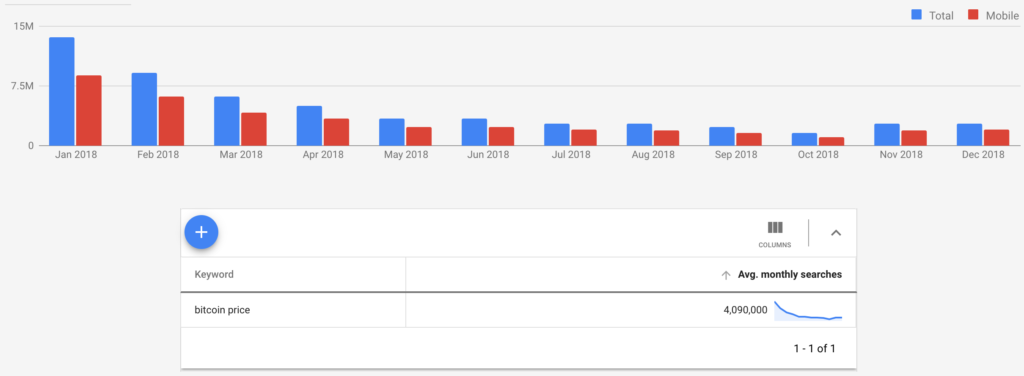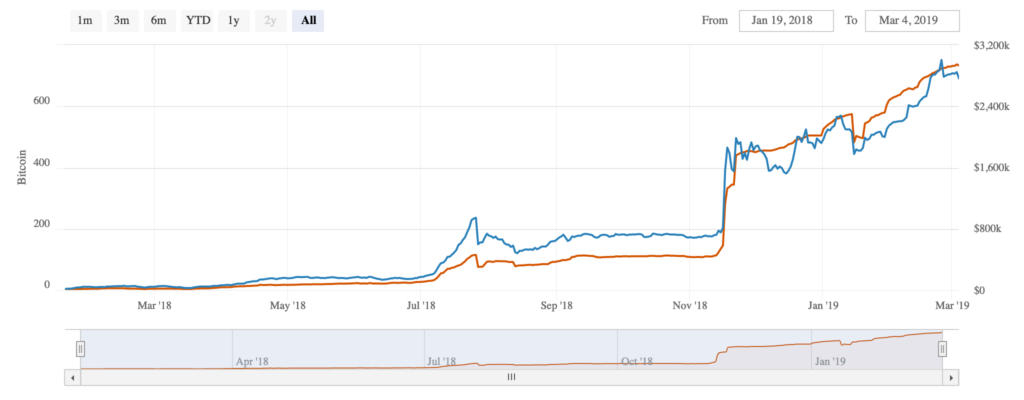Did you know that the term “bitcoin price” was Googled over 4 million times per month in 2018?
In fact, in January 2018, it was searched for nearly 15 million times.
Crazy right? People really care about the price.
This is perhaps unsurprising. Bitcoin’s price has skyrocketed to dizzying heights and then collapsed in upon itself more times than you can count. Enthusiasts have made and lost fortunes in the blink of an eye.
The phrase “when moon” will be familiar to anyone who has joined a crypto Telegram Group. It’s indicative of the potential cryptocurrency has to double, triple or even 10x in value. If huge returns are the moon, then Bitcoin is the Apollo program.
Like moths to the light, get-rich-quick types have been drawn to bitcoin, hoping to make a fortune simply by buying low and selling high.
Of course, it is not just traders who reduce bitcoin to its price tag. The media – both old and new – have become obsessed with the godfather of modern cryptocurrency. According to the excellent “Bitcoin Obituaries” the media has declared the death of bitcoin 344 times – mostly as a result of tumbling prices.
Obviously, bitcoin is not dead. Indeed, it seems to have been forgotten that bitcoin’s death has become something of an impossibility. There will always be enthusiasts, nerds, academics, kids, university students, historians and others who will study and support bitcoin. Whether by owning some for sentimental value, running a node to see what it’s like to participate in a trustless network, or to speculate on the price. Bitcoin is alive, and I doubt it can even be killed.
Why Bitcoin’s price isn’t important (anymore)
What’s clear is that Bitcoin’s price is not a good indicator of value. In December 2017, the price of Bitcoin – and almost all other cryptocurrencies – exploded. On December 17th, one Bitcoin was suddenly worth $19,783 (!!!), up from just $8,100 a month before.
- Had the use cases for Bitcoin drastically changed?
- Had the functionality of Bitcoin significantly improved?
- Had the adoption of Bitcoin exploded?
The answer to all three questions is: No. Instead, the massive increase in the Bitcoin price was down to “bullish sentiment” according to Coindesk. After the “summer of crypto love”, traders simply and foolishly believed that months of growth must be followed by even more growth.
Naturally, the market quickly recognized that this increase was not backed by anything substantial and began the decline it has been on ever since.
But that doesn’t matter. The price explosion in December of 2017 brought Bitcoin to the public’s attention, with a recent YouGov poll finding that an impressive 71% of Americans have heard of Bitcoin. Just as importantly, 50% of millennials are reportedly interested in using cryptocurrency as a primary form of payment.
These numbers suggest that cryptocurrency-powered solutions will now find a much more receptive audience than just a few years ago. This is the key to Bitcoin’s future, as long-term survival is impossible without some semblance of adoption.
I don’t say this to dishearten us. Quite the opposite.
We remain in the “installation phase” of #crypto (image: https://t.co/8oOws39TaS), where the primary users are developers & investors.
There is so much left to build and promise to be realized, which is massively exciting! pic.twitter.com/9pfy5MmJ1k
— Chris Burniske (@cburniske) January 5, 2019
Why is adoption more important for Bitcoin?
So far we’ve learned that Bitcoin’s price does not reflect its value and is therefore not a good indicator as to its future prospects.
Instead, I believe that adoption is the best way of measuring Bitcoin’s value. In this context, adoption refers to people’s willingness to use Bitcoin. The more people use Bitcoin, the more problems it must be solving. Your average westerner might not yet understand why a permissionless, digital currency is important, but what if you ask someone living in Venezuela?
Bitcoin as a safe haven
In a country wracked with hyperinflation and political instability, Bitcoin provides each Venezuelan with the opportunity of becoming his or her own bank. Sure, Bitcoin might still be volatile compared to the USD but it’s far more stable than the Bolívar Soberano – which could reach an inflation rate of 10 million percent this year. As a result, Venezuelans are increasingly turning to Bitcoin as both a store of value and a medium for exchange.
A similar, though less pronounced, story has been unfolding in South Sudan, where inflation hit 476% in 2017. The youngest country in the world has been in the grasp of a vicious civil war since 2013, with warlords fighting over the country’s vast oil supplies. Described in this excellent article, South Sudan natives like Kueth Duany, have been able to use Bitcoin to escape the nation’s burgeoning hyperinflation.
Political and economic turmoil can also be wrought by external forces however, as was the case in Turkey. When Trump doubled steel and aluminum tariffs, the Lira plummeted by 20%. The countries largest exchange registered a 63% surge in Bitcoin’s trading volume as people flocked to the relatively safe haven.
It seems clear at this point that Bitcoin provides a viable solution to people living in politically or economically tumultuous countries. Its impressive liquidity coupled with relative price stability, make it an excellent alternative to collapsing fiat currencies.
Bitcoin’s use for remittances
Another important use case for Bitcoin is focused on the remittance industry. A remittance typically describes the regular transfer of money by a foreign worker to his or her family still living in their home country. According to the World Bank, global remittances grew by 10% in 2018, with most of the funds being sent to developing countries.
Naturally, families living in developing countries are particularly price-sensitive. It makes a meaningful difference if $100 is received or if fees reduce that amount down to $90. Companies like Western Union and MoneyGram typically charge substantial fees, especially to sub-Saharan countries.
This is another great way for Bitcoin to achieve meaningful adoption. As of 2019, the average transaction fee is only a few cents, meaning that remittances are made significantly cheaper by using Bitcoin. In this case, Bitcoin has the power to improve the lives of millions of people. That’s far more important to its long-term success than the price.
Bitcoin’s use for remote working
An example of Bitcoin’s true value can also be found closer to home (badum tish). In recent years we’ve seen the emergence of digital communication and productivity tools which make working remotely much more feasible. Tools like Slack, Asana, Trello, and Google Drive have removed the need for employees to work in one central location.
One of the great challenges for remote work companies is paying employees scattered all over the world. International bank transfers are still shockingly expensive, with fees typically ranging anywhere from $10 to $50. For a one-time payment, this might be manageable but imagine paying $25 in fees for each of your 10 employees over a sustained period of time. That’s $3,000 in fees per year. Oof.
Bitcoin is perfectly situated as the default currency for remote working companies. Anyone with an internet connection can receive it, and fees are almost negligible. Importantly, selling your Bitcoin has never been easier. Exchanges like Coinbase allow you to instantly buy or sell Bitcoin, and similar services exist all over the world.
Let’s also not forget that Bitcoin’s speed is another significant advantage for remote work companies. As an employer, you want to ensure that your staff are paid in a timely manner. That being said, you do not want to pay wages until the requisite work has been done. Using international bank transfers, it might take several weeks before an employee receives his pay. So far in 2019, the average Bitcoin confirmation time stands at 9.2 minutes.
As a result, Bitcoin allows remote work companies to make significant savings, while also paying staff in a timely manner.
Plenty of use cases for adoption but what about the mainstream?
The three use-cases listed above show how Bitcoin is already being deployed to solve real-world problems. Reading through them, you might be forgiven for thinking of alternative services which could solve the problem instead.
Digital banks like Revolut, Transferwise or N26 for example, already provide a workable solution for remote work companies. With this in mind, Bitcoin needs to establish some semblance or mainstream adoption. Once a significant number of people use it, the network effect will take hold, incentivizing others to adopt it as well.
The keyword regarding mainstream adoption has always been scalability. Scalability refers to the capacity of Bitcoin’s blockchain to quickly process a large volume of transactions. At present Bitcoin is limited to 7 transactions per second, which is far too little for mainstream adoption.
For the first time in ten years however, we seem to be making significant progress regarding scalability. More specifically, the lightning network has shown great promise and might be the solution to Bitcoin’s historic scalability woes.
Acting as a secondary layer on top of the blockchain, the lightning network allows for almost instant Bitcoin transactions. By processing transactions off-chain it could scale to 50,000 transactions per second. Encouragingly, the lightning network has already processed over $2.2 million and the volume is continually increasing.
Conclusion – Adoption over price
Bitcoin has become the internet’s phoenix. Every time it crumbles into ashes, it returns reborn and stronger than ever. Despite negative legislation and nasty PR campaigns, Bitcoin survives and brings value to hundreds of thousands of people.
Value, as this article has shown, is far removed from price. Bitcoin’s longevity will not be determined by the number of zeros it commands, but by the problems it solves. Luckily Bitcoin is well positioned to solve an array of pain-points across many different industries. It is already making a positive impact today, and will surely make an even bigger impact tomorrow.







Leave a Reply